Some time ago I wrote about how the Maritime and Colonial League (LMiK) wanted to colonize with the help of potties… come back! Establish trade relations with Liberia. Today is the time for another portion of information about the activities of our home-grown colonizers of the Black Continent. This time we will go with them to "conquer" Angola.
In the interwar period, Angola was the largest Portuguese colony. One million two hundred thousand square kilometers on paper is impressive, but the country was very sparsely populated. At the end of the 1930s, it was inhabited by only about 2.5 million people, overwhelmingly indigenous. The area had - and still has - many natural resources, such as metal ores (including precious ores), diamonds, crude oil and natural gas. Additionally, due to the equatorial climate, the cultivation of coffee, cotton and rubber developed well there.
Angola - a good territory for Polish colonial expansion!
All these factors meant that in 1927 Angola was in the crosshairs of the Sea and River League (the predecessor of LMiK). On April 22, 1928, the president of the Association of Colonial Pioneers (one of the League's sections), Kazimierz Głuchowski, went to Lisbon.
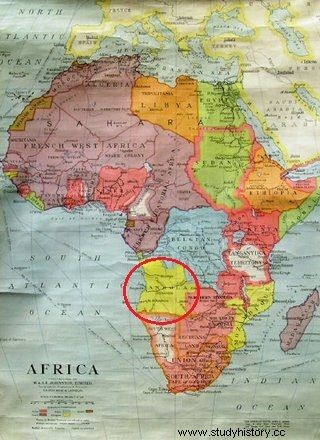
Angola is about… here. On the map from 1930.
The purpose of the trip - as reported by the Ligia body, the monthly "Sea" - was to implement negotiations with the Portuguese government or railway companies in Angola on obtaining areas in Angola suitable for Polish colonization expansion. After his return to Poland on May 15, the June issue of "Woda" announced:
Investigating the case in the capital of the metropolis further strengthens the Union's belief that Angola is suitable for agricultural colonization and Polish settlement. In Lisbon, Mr. Gołuchowski met with keen interest from local factors related to Angola economically, who are willing to make a whole range of facilities for Polish action.
Further action will therefore be lively, moving towards the practical implementation of the project.
In fact, things turned out "vividly". Articles popularizing Angola as a convenient place to move appeared every now and then in the press (both league and daily). There have even been several brochures on issues related to the geographic conditions and the realities of economic activity in that area. Obviously, they assessed the prospects for Polish economic expansion very positively
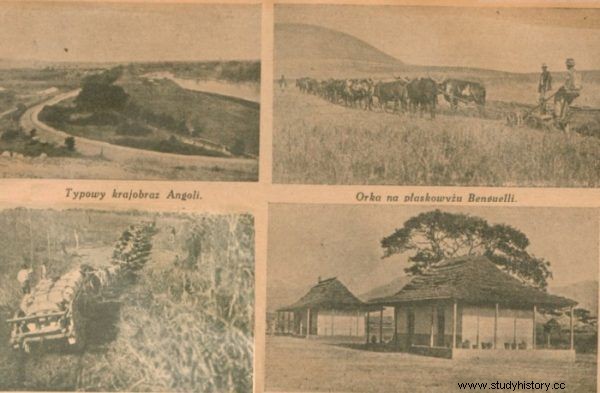
A collection of Angola's photos from the "Sea" monthly:landscapes, farm work, transport and colonists' homes.
All this resulted in the sending of a special expedition to this Portuguese colony by the Scientific Colonial and Emigration Institute and the Polish Tropical Research Station on December 14, 1928. The purpose of the expedition, led by Franciszek Łyp, was to investigate the chances of success of a possible Polish settlement action on the spot.
The results of the reconnaissance turned out to be promising, because in Angola - unlike, for example, Brazil - it was not so much strong hands, rather capital, as there was no shortage of cheap labor on the spot. However, in order to be successful, you had to invest a lot. According to Tadeusz Białas in his book "Liga Morska i Kolonialna 1930-1939", Łyp estimated that the colonist had to have at least ten thousand zlotys (which was the equivalent of about 89,000 zlotys at that time).
The expenses related to the purchase and equipment of the farm were to consume eight thousand, two thousand should be a reserve for the "rainy day". So Angola was considered a convenient settlement area, but only for the wealthy.
Poles are starting to colonize Angola
Due to such optimistic forecasts, the year 1929 was marked by preparations for the dispatch of the first Polish settlers. A special organizing committee for the company "Polangola" was created for this purpose to deal with trade and economic relations with Portugal and its colonies.
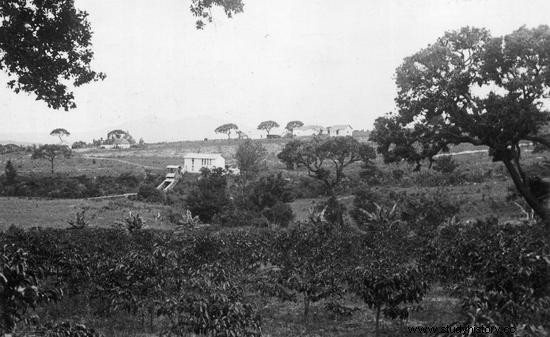
Polish farm, coffee plantation, mill and residential buildings in Boa Serra, Angola. Photo taken by Kazimierz Nowak during his journey through Africa.
The cooperative "Alfa" and the Society for the Colonization of Angola were also established, the tasks of which were included in the name of the latter. Care was even taken to include a confidential settlement clause in the Polish-Portuguese trade treaty signed in autumn that year, ensuring that Polish citizens have equal rights in terms of social welfare and labor protection.
Now there is nothing else to do but start the colonization. The paving of the trails fell to Count Michał. Zamoyski, who set off for Lisbon with his wife on December 7, 1929. Then, on December 20, the Zamoyski family on board the ship headed towards Angola, where they intended to establish a plantation.
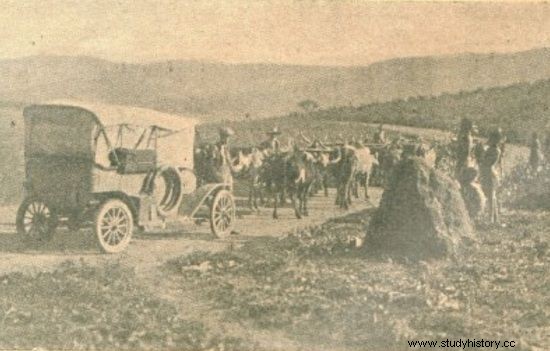
Colonizing backward Africa? Not really… anyway, they had better roads in Angola than ours! Juliusz Gebethner wrote in 1938 in his report from Angola:"I left Lobito by car to Posto Quipeio, which is the center of Polish colonists, and most of all I noticed that the road surface is simply perfect. In spite of his will about the relatively recent ride on our roads - the comparison was definitely in favor of Africa "(" Sea ", April 1938).
At the same time, the count was a representative of the company "Polangola". Another group of colonizers set off six months later. It consisted of six members of the Union of Colonial Pioneers, led by Eng. Adam Paszkowicz. They planned to engage in cattle breeding and industrial activities. In September 1932 the agronomist Jerzy Chmielowski joined them.
Blowing up the topic of emigration to Angola in the press, of course, gave fraudsters an opportunity to trick naive people with promises of future prosperity in Africa. Even in April 1931, a warning against such practices appeared in the pages of "Sea". Editors stated:
As we have been informed by the provinces, many peasants and even larger landowners fell victim to mysterious agents who, having collected considerable amounts of cash, disappeared without a trace. Fraud can reach several or even several dozen thousand zlotys in one case.
In addition, there were mysterious advertisements in the Warsaw press, calling on interested parties to turn to unknown benefactors who even intend to publish a magazine (sic) devoted exclusively to Angola.
Angola not for Poland
The most interested party, ie the authorities in Lisbon, also reacted to the "media hype" in the Polish press around Angola. Minister Beck noted in his memoirs that: the Portuguese government took a hostile position towards our policy, and in England the most serious factors reflected on Poland's dangerous aspirations .
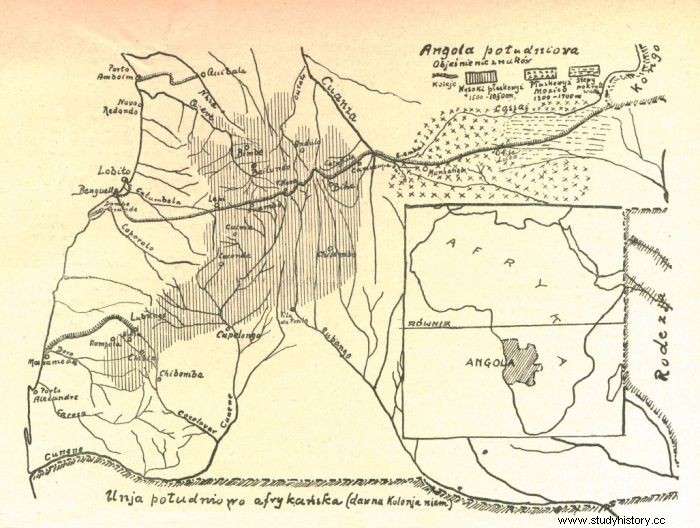
Angola on the next map - this time Polish, from the monthly "Sea" (No. 9-10, 1929).
The Portuguese, wanting to make the influx of new foreigners to the colonies more difficult, introduced a number of difficulties for those who wanted to settle in the areas designated for this purpose. Of course, this also applied to our compatriots, an example of which was forcing Poland to give up the aforementioned confidential settlement clause.
Therefore, for a few years the case of Angola was quiet, but anyone who thought that this was the definitive end of dreams about the equatorial Eldorado would be wrong. The topic returned in the late 1930s. This time the driving force behind the action was not the League, but the Polish Ministry of Foreign Affairs, which considered sending economic and human expansion to Angola.
In the aforementioned book by T. Białas, we can find information on projects to purchase up to 20,000 hectares land in Angola, in order to conduct colonization and plantation actions. Due to the reluctance of the Portuguese government, a fictitious company was to be used that would purchase the land for 13,100 francs.
Purchase of the majority stake in the "Cabinda" campaign, operating in areas administratively owned by Angola, was also considered for PLN 1,800,000. In the end, nothing came out of both ideas, and the article by Juliusz Gebethner in the April 1938 issue of "Sea" may serve as the best summary of the entire Angolan "event". The author lists only five Polish plantations in this country.
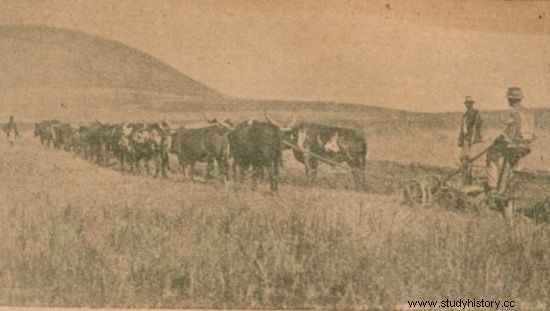
In 1938, only five Polish colonies remained in Angola. This is how the dream about our equatorial El Dorado ended. The photo shows a killer whale on the Benguelli plateau.
As if to be consoled, he added that we will soon have our own coffee in Poland, planted by Polish settlers , however, as we all know, one and a half years later, the war broke out and we were not able to taste the taste of Polish beans in Angola.
